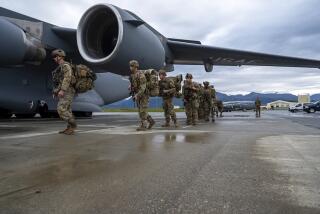Russians Cocky Over U.S. Encounter
- Share via
MOSCOW — Crowing with pride, Russia’s air force chief claimed Wednesday that a group of Russian warplanes buzzed the U.S. aircraft carrier Kitty Hawk in the Sea of Japan, taking pictures of the reaction on deck, in an episode that flashed back to the cat-and-mouse games of the Cold War.
“For the Americans, our planes were a complete surprise,” boasted Gen. Anatoly M. Kornukov, the Russian air force’s commander in chief. “In the pictures, you can clearly see the panic on deck.”
Kornukov said the Russian warplanes managed to evade the antiaircraft defense system of the U.S. vessel and fly over the ship not once but twice--on Oct. 17 and Nov. 9. As Russian military analysts noted it was rare for Russian planes to get so close to a U.S. aircraft carrier, Kornukov gleefully promised to recommend medals for the pilots involved.
U.S. Navy officials acknowledged Wednesday that three Russian surveillance flights had taken place on those dates but insisted that U.S. forces were aware of them as they occurred and didn’t view them as threats.
Lt. Cmdr. Conrad Chun, a Navy spokesman in Hawaii, said the Russian aircraft were identified and tracked by U.S. fighters and other intelligence means that he wouldn’t identify. Those means would presumably include radar aboard the Kitty Hawk.
“We took the appropriate action,” he said.
With Russia’s military in decline and the morale of its service members low, Russian generals and media made the most of a rare opportunity to boast about military feats.
The national ORT network reported “an impressive demonstration of might in the air” by the pilots. And Kornukov said, “The results of the reconnaissance exercise are impressive and the quality is highly appraised.” The air force didn’t release the reconnaissance photographs.
During the Cold War, the United States and the Soviet Union, trying to avoid international flare-ups, developed agreements governing encounters between ships and aircraft at sea. Both sides said Wednesday that the Russian overflights didn’t violate those rules.
The U.S. and Russian militaries are now on friendly enough terms that their naval vessels make reciprocal port calls. But the two nations’ aircraft and ships occasionally still have encounters as they seek to train their forces and gauge their readiness for war.
Kornukov said the purpose of such exercises was both to train air crews and glean intelligence.
Alexander Vladimirov, a Russian military analyst with the Collegium of Military Experts in Moscow, said the Americans should have found, warned and, if necessary, intercepted the Russian intruders long before they approached the ship.
“The Americans here demonstrated a surprising lack of vigilance and discipline,” he said. “For all their showcase military might, they demonstrated how vulnerable they may be when taken unawares in a situation like this.”
According to the Russian side, the U.S. aircraft carrier was refueling in the Nov. 9 incident and couldn’t raise its jets until the Russian jets had twice passed overhead. The Russian SU-24MR reconnaissance planes were escorted by a squadron of SU-27 interceptors, Kornukov said.
Gen. Anatoly Nogovitsin, commander of the 11th Air Army, said the Americans began hastily cutting off their refueling pipes so that they could get their planes into the air.
“They accompanied us after that, but the deed had already been done,” he said, grinning. “As to them, their commanders will have to sort out what happened.”
Russian military analysts said U.S. planes fly over Russian vessels regularly, but according to Russian media reports, the last time a Russian plane managed a similar feat was in the early 1970s, and the crew was awarded the Order of Lenin, one of the highest Soviet state awards.
In July last year, during high-profile war games just weeks after NATO’s bombing campaign in Yugoslavia ended, a pair of TU-95 long-range Russian bombers flew from northern Russia to within 60 miles of Iceland, where they were intercepted by American F-15 fighters. U.S. military officials speculated at the time that the Russians wanted to demonstrate that they still represented a threat, and to bolster morale within their forces.
The Sea of Japan incidents come against the background of a deterioration in relations between Russia and the United States after the North Atlantic Treaty Organization’s expansion eastward, which Moscow resisted, and the NATO bombing campaign.
Relations have been aggravated recently by the Russian navy’s insistence that a foreign submarine, American or British, collided with the Kursk nuclear submarine while shadowing it during naval exercises in August, leading to the blasts that killed all 118 on board. Another irritant is the continuing espionage trial in Moscow of a U.S. businessman, Edmond D. Pope.
Larry Seaquist, a retired U.S. Navy captain, said the incidents involving the Kitty Hawk were a “very interesting” sign that despite the long-term thawing trend between the U.S. and Russian militaries, the Russians occasionally revert “to their old tricks.”
“It seems to me they’re showing off,” Seaquist said.
Vladimirov, the analyst, speculated that the pilots acted on their own, without orders from above.
“I would call it just lighthearted hooliganism on the part of the Russian pilots but for the grave consequences it could have caused,” he said. “These tricks are not only in bad taste but potentially dangerous too.”
Seaquist said that with shortages of spare parts, funds and even food, “these poor guys can barely get airborne. . . . There’s really nothing there that we can’t handle.”
*
Dixon reported from Moscow and Richter from Washington. Sergei Loiko of The Times’ Moscow Bureau contributed to this report.
More to Read
Sign up for Essential California
The most important California stories and recommendations in your inbox every morning.
You may occasionally receive promotional content from the Los Angeles Times.














